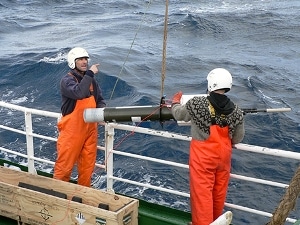Jan 16 2018
The efficiency of the North Atlantic Ocean carbon pump is largely governed by the phytoplankton blooms. For gaining an in-depth knowledge of this phenomenon, the ERC remOcean project, headed by scientists from the Laboratoire d’Océanographie de Villefranche (CNRS/UPMC), has created an innovative category of robots - biogeochemical profiling floats, the first robots with the potential to gather data from the ocean right through the year.
 Deploying a float. (Image credit: Léo Lacour)
Deploying a float. (Image credit: Léo Lacour)
By analyzing this unprecedented data, the scientists have recognized the starting point for the intense spring phytoplankton bloom. The outcomes have been the subject of two articles published in the journals Nature Geoscience and Nature Communications.
The North Atlantic Ocean positioned over the 50th parallel north is among the most efficient carbon sinks across the globe. Despite the fact that it constitutes less than 1.5% of the total surface area of the oceans in the world, it captures nearly 20% of the CO2 isolated by the oceans. The highly cold surface waters and comparatively extreme weather conditions in winter in the North Atlantic Ocean allow effective capture of CO2 from the atmosphere. Simultaneously, phytoplankton blooms also play a vital role in the capture of CO2 and its prospective transport to the deep ocean, where phytoplankton is a plant micro-organism that converts the inorganic carbon contained in the ocean into organic carbon through the process of photosynthesis.
Conventionally, phytoplankton blooms are noticed through satellites that show the presence of chlorophyll by recognizing the color of the ocean, though they seem to be ineffective during the presence of cloud cover; and also through oceanographic missions, which are costlier to operate and restricted in time.
In order to obtain a better knowledge of the conditions apt for phytoplankton blooms, scientists from the Laboratoire d’Océanographie de Villefranche (CNRS/UPMC) have installed robots known as “biogeochemical profiling floats” from 2012–2013. These robots, which function from the surface up to a depth of 2000 m, have enabled the recording of data that have earlier not been gathered over a complete annual cycle, including the temperature, depth and salinity of the water, and also light intensity, concentration of both chlorophyll (which indicates the presence of phytoplankton) and oxygen, and density of suspended particles.
The researchers used the gathered data to accurately determine at what time and the way in which the phytoplankton bloom is triggered in the North Atlantic Ocean. Their research will be reported in the Nature Communications journal and corroborates the postulate that an intense increase in phytoplankton biomass happens in spring after a “winter simmer,” a phase of decreased activity in the winter time.
Moreover, the scientists concentrated on the months of January, February, and March to analyze this poorly perceived “winter simmer” phenomenon. In another research reported in the journal Nature Geoscience, they demonstrate that (decreased) phytoplankton blooms may occur during winter under specific conditions. Phytoplankton cannot bloom in highly turbulent and rough waters as there is a lack of light during this time of the year. Yet, this research demonstrates that at the time of relatively calm periods, the decreased mixing of waters enables phytoplankton to get more light, thereby inducing blooms of a kind of phytoplankton known as diatoms. The local blooms that last for a few days could prove to be the initiating point for the intense spring blooms after a few months. Such observations have been reproduced by numerical models and will surely be fed into upcoming forecasting models of the state of oceanic ecosystems.
Apart from these outcomes, the ERC remOcean project showed the significance of robots in enhancing the knowledge about the ocean. It also assisted in initiating an international robotic ocean biogeochemistry monitoring program, Biogeochemical-Argo, which was started in 2016. Its medium-term goal is to install 1000 profiling floats for continuous monitoring of marine life in the oceans and its responsiveness to climatic disturbances.